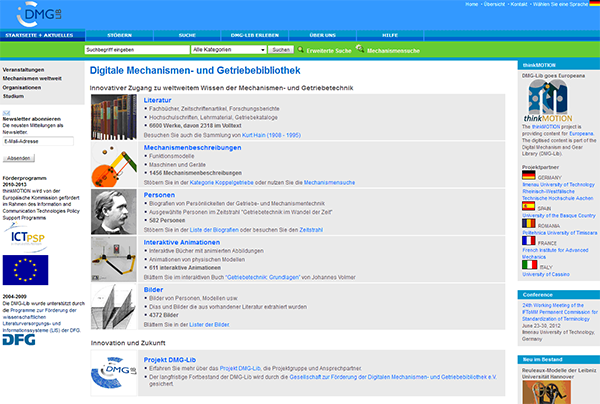Motion systems are important parts of technical products. Those are mostly composed of mechanisms and gears. Today mechanism and gear technology is essential for the whole industry and it will become even more important due to the introduction of new technologies and respective new fields of applications.
However, the existing knowledge about mechanisms in theory and practice is scattered worldwide in hand- and textbooks, photographs, solid functional models, engineering drawings, etc. These are very limited, scattered and only fragmentarily accessible. This does not comply with today’s requirements concerning a rapid information retrieval. However, industrial companies and research institutes demand an efficient access to the whole mechanism and gear theory. Existing activities to provide such access are promising, but by far insufficient. The preservation of knowledge and didactic experiences in mechanism theory is also important, because e.g. education material often gets lost when lecturers retire. Old and unique literature and physical models with only a few of them left are quite difficult to be accessed (Fig. 1b and c). They need to be digitized and posted online, being accessible for the public again. A solution for this will be the collection and presentation of all relevant information resources for mechanism and gear science in a centralized worldwide accessible platform. A comprehensive library of knowledge benefits research and education in several engineering disciplines.
In 2004 the development of the worldwide accessible “Digital Mechanism and Gear Library” (DMG-Lib, www.dmg-lib.org) was started as an interdisciplinary project involving different departments of the Technical Universities of Ilmenau, Dresden and the RWTH Aachen. The aim of this project is the collection, integration, preservation, systematization and adequate presentation of the worldwide knowledge about mechanisms and gears. The gained results and experiences of this project will help future digital libraries in different application domains as well. The digital library is designed to satisfy the requirements of different user groups like engineers, scientists, teachers, students, librarians, historians and others. To offer users a wide variety of opportunities for retrieval and use, the digitized resources are extensively post-processed and enriched with various information like animations, metadata, references and constraint based models. The focus is not only on textual documents, images and animations, but also on digitalized functional models. Thousands of such unique models exist, with no or only very limited access for the public. This huge amount of available heterogeneous information resources in the DMG-Lib combined with innovative multimedia applications and a semantic information retrieval environment implies a key challenge of this project: the implementation of an efficient, uniform and user-satisfying information retrieval.

Sources of the DMG-Lib
The original sources are selected, digitized and converted to suitable data formats. The information resources can be accessed worldwide on the DMG-Lib internet portal. This simplifies the access and distribution of these information resources, but does not directly enhance a goal-oriented usage and retrieval of solutions of technical tasks in research and industry. Furthermore the common storage method for knowledge, mainly in static texts and images, does not comply with requirements concerning an efficient and quick information retrieval. The advantages of functional models for a better understanding of complex construction and function principles are well known. Today the necessary techniques are available to digitize such models and to provide an easy access to such helpful demonstration models for a broad public. Computer-based methods enable the generation of multimedia documents, which describe the function and other relevant attributes of mechanisms and gears. These can easily be distributed and enriched with extensive additional information. The DMG-Lib workflow covers the identification of sources, clarifying rights, digitization, conversion, enrichment and transfer of the resulting content into www.dmg-lib.org.
For the implementation of this ambitious concept a consequent cooperation between information, computer and usability scientists as well as engineers, librarians and experts of mechanism and gear science is necessary. This is the only way to collect, enrich and present the complex domain specific heterogeneous information resources according to the user requirements.

Enhancement of a video by an overlaid simulation-based animation created by the animation generator
The DMG-Lib supports engineering designers in finding ideas for design solutions, calculation procedures, adequate technical terms, detailed structural and functional descriptions, historic publications in different languages, etc. It helps young people to discover interests in mechanical engineering as well as it opens doors for further education possibilities. The DMG-Lib project is an example of a modern knowledge space and fulfils one of the key tasks in today’s information society, satisfying user’s needs for getting an efficient access to required information.
Currently appr. 7.200 textbooks and papers in full text, 1.500 mechanism descriptions, 600 interactive animations and 11.000 images are available via the project website.

DMG-Lib project website
The DMG-Lib project was financed by the “Deutsche Forschungsgemeinschaft” (German Research Foundation).
A list of publications is available at the web address www.dmg-lib.org .